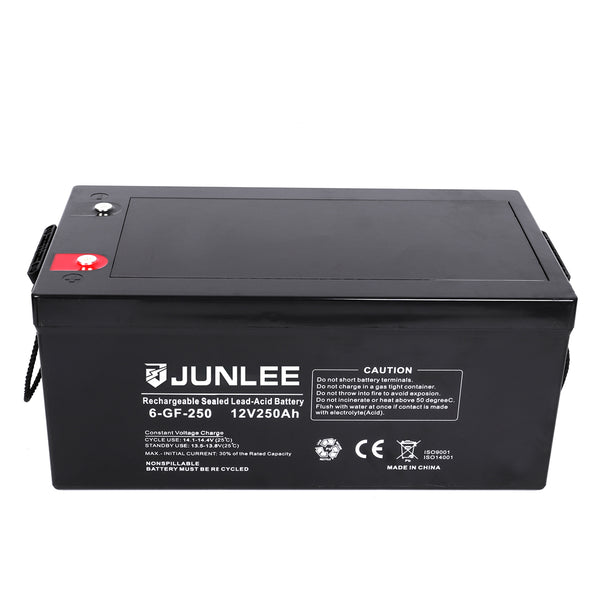AGM type battery uses pure sulfuric acid aqueous solution as electrolyte, and its density is 1.29-1.3lg/cm3. Most of it exists in the glass fiber membrane, while a part of the electrolyte is absorbed inside the electrode plate. In order to provide a channel for the oxygen precipitated from the positive electrode to the negative electrode, it is necessary to keep 10% of the pores of the separator not occupied by the electrolyte, that is, the lean design. The pole group adopts a tight assembly method to make the pole plate fully contact the electrolyte. At the same time, in order to ensure sufficient battery life, the electrode plates should be designed to be thicker, and the positive grid alloy uses Pb’-q2w-Srr--A1 quaternary alloy. AGM-type sealed lead batteries have less electrolyte, thicker plates, and lower active material utilization than open-ended batteries, so the discharge capacity of the battery is about 10% lower than that of open-ended batteries. Compared with today's gel-sealed batteries, its discharge capacity is smaller.
The AGM battery is the earliest invented and widely used storage battery. It is a valve-regulated sealed lead storage battery (also called VRLA storage battery) that uses a glass avant-garde separator (AGM). The sulfuric acid is absorbed by a very fine glass fiber mat, which prevents the battery from overflowing. In this way, without restrictions on hazardous materials, these plates can be made flat, similar to the standard submerged lead-acid package in a rectangular box, and they can also be wound into a cylindrical battery.
The AGM battery has a very low internal resistance, can provide high current on demand, and can provide a relatively long service life even in deep cycles. AGM storage batteries are maintenance-free, provide good electrical reliability, and are lighter than lead-acid battery types. Although conventional lead-acid batteries require a castable every six months to prevent the accumulation of sulfation, AGM batteries are less prone to sulfation and can be stored for a longer period of time before needing to be charged. The battery performs well at low temperatures and has a low self-discharge rate.
The advantage of the AGM battery is that the charging speed is 5 times faster than that of the lead-acid battery, and it also has the ability to deep cycle. AGM batteries provide 80% depth of discharge. On the other hand, lead-acid batteries are specified as 50% DoD to achieve the same cycle life. The negative specific energy is slightly lower. The manufacturing cost is higher than lead-acid batteries, but cheaper than gel batteries. . Most batteries are medium-sized batteries with a battery voltage ranging from 30 to 100Ah. They can also be found in UPS, regardless of size, for fixed and deep cycle use. AGM batteries are usually made to size and can be used in high-end vehicles to run power-hungry accessories such as heated seats, steering wheels, rearview mirrors and windshields.
At the same time, AGM storage battery is the first choice for high-end motorcycles. The AGM storage battery is sealed to reduce acid overflow in accidents, reduce weight to achieve the same performance, and allow installation at odd angles. Due to its good performance at low temperatures, AGM batteries can also be used in marine, automotive and robotic applications. The AGM battery is entering the start-stop function of the car. The classic lead-acid battery is not strong enough, and after two years of repeated use, there will be a significant capacity decline. Like all gels and sealing devices, AGM batteries are sensitive to overcharging. Charging to 2.40V/battery (and higher) is good. However, the float charge should be reduced to between 2.25 and 2.30V/battery (lower voltage may be required for summer temperatures). Car charging systems for lead-acid batteries usually have a fixed floating voltage setting of 14.40V (2.40V/battery), and direct replacement with a sealed device may overcharge the battery on the long drive. AGM batteries and other sealed batteries are not suitable for heating and should be installed away from the engine compartment. If the battery cell reaches 49°C (120°F), stop charging.


